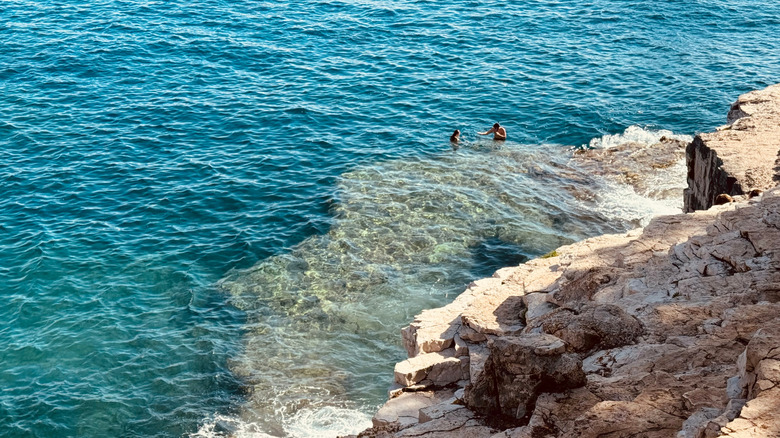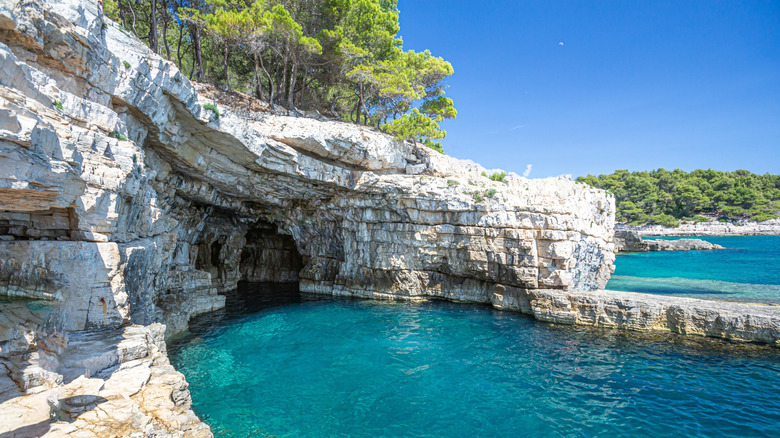Croatia's 'Seagull's Rocks' Beach Is A Breathtaking Escape With Stunning Water & Cliffs
The rugged, rocky coastline of Croatia has plenty of fans these days. Seen by some as being like the Amalfi Coast but without the price tag, Croatia's lengthy coast is a paradise of hidden bays, forested islands, craggy cliffs, and gorgeous beaches. With its intriguing history, delightful, seafood-led cuisine, and some truly beautiful landscapes, Croatia is a captivating coastal country in Europe that will take your breath away.
Many spots along southern Croatia's Dalmatian Coast have become somewhat overwhelmed with tourists and day-trippers, but there are still plenty of hidden gems for the savvy traveler to explore. In the north of the country, Istria offers the best of the Croatian coast without the crowds (according to Rick Steves). This small peninsula juts out into the Adriatic Sea near the borders of Italy and Slovenia, and it's full of excellent under-the-radar destinations. One such spot is Seagull's Rocks, a stunning beach boasting crystal-clear water and backed by majestic cliffs.
Seagull's Rocks (Galebove Stijene) is just outside the city of Pula on the southern tip of the Istrian peninsula. It is a short drive from the city center, and there is also a bus (number 4) that runs regularly to the neighborhood of Stoja, a 10-minute walk from the beach. The nearest international airport is Pula Airport, served by seasonal flights from around the continent.
Go cliff diving, snorkeling, and explore sea caves at Seagull's Rocks beach
While Pula and the entire Istrian peninsula still fly under the radar as tourist destinations, Seagull's Rocks are pretty recognizable. The high cliffs, dramatic outcrops, and crystal-clear waters are a feature of in-the-know travel magazines and social media outlets, and the bay is probably the most famous swimming spot in Istria. The best way to enjoy Seagull's Rocks is to do as the locals do. Find a spot on one of the flat, warm rocks, spread out a beach towel, and alternate between diving off the rocks into the sparkling water and enjoying the stunning views of the Adriatic.
Seagull's Rocks is also one of Pula's top snorkeling spots, perfect for immersing yourself in the aquatic world of the Adriatic Sea. The waters around Pula offer amazing visibility, beautiful and mysterious underwater grottos and caverns to explore, and a diverse marine population, from feather starfish, crabs, and sea cucumbers to octopuses, sea turtles, and three different dolphin species!
One of the best ways to explore the coastline around Galebove Stijene and Pula is on a sea kayaking adventure. Numerous operators run guided tours from Pula Marina, taking visitors paddling around the hidden bays, craggy coast, unique rock formations, and magical sea caves that can only be accessed by water.
Visit the Roman ruins and Venetian fortification near Seagull's Rocks
Pula itself is well worth exploring in detail. It is one of Croatia's busiest ports, home to a large naval base and shipyard, as well as some exceptional Roman ruins that elevate it from a functional, undemonstrative city into one of the country's most fascinating hidden gems. The highlight is Pula Arena, a stunning amphitheater that dominates the city center, situated next to the harbor. Pula Arena is Croatia's best-preserved ancient monument and a Roman Colosseum lookalike. The impressive Temple of Augustus and the Arch of the Sergii are also worth checking out. Part of Pula's charm is how its Roman history is scattered throughout the city in unexpected places. For example, tucked behind a parking lot near Sergijevaca is an exquisite and extremely well-preserved tile mosaic dating from the 3rd century.
History and culture in Pula are more than Roman ruins. The city's long and rich heritage is evidenced in places like the star-shaped fortress, a relic of the Venetian fortifications, when much of the Croatian coastline was under the control of the Doges of Venice. It now houses the Istria Historical & Maritime Museum, which puts on a varied range of temporary exhibitions and permanent displays, from stories about the partisans who fought against Nazi occupation to the history of the local boxing club. Fans of modern history will also want to explore the Zerostrasse network of tunnels, originally built to store ammunition and protect the people of Pula in the event of attack.


